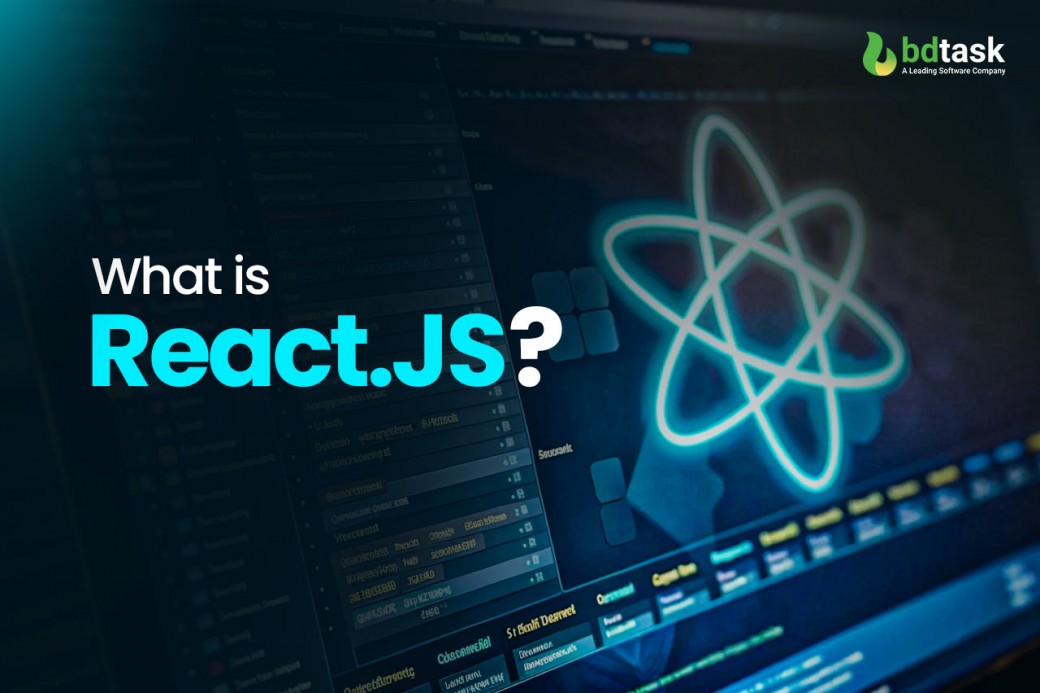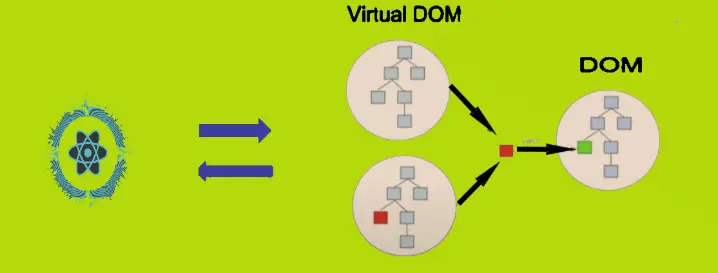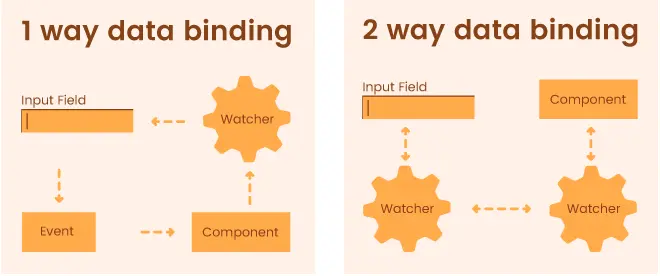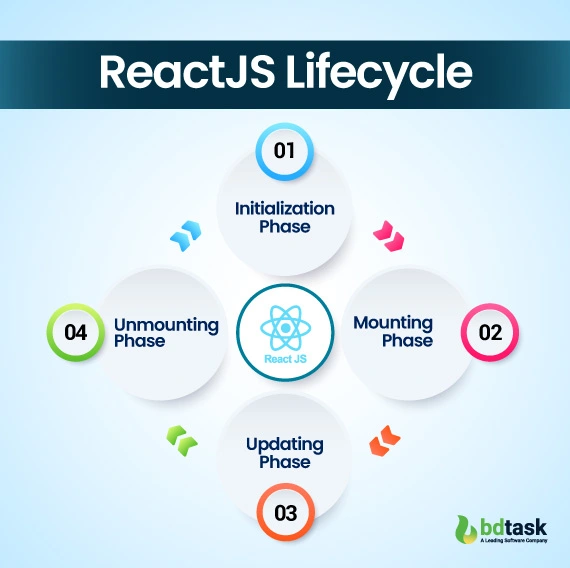What is React Js and How it Works

Web and mobile applications have become an important part of the modern age. Different types of technologies are invented continuously to become more and more advanced.
React front-end library is one of those inventions. React has brought a lot of voluntary changes to the web application. The use of React has become a part of a web developer who works for front-end development.
In that case, knowing what is react js and how it works is compulsory. So, for proper understanding, stay with us and explore all the details of react.
What is React JS
React is an open-source front-end framework. It is a very powerful JavaScript library developed by Facebook. React has a user interface library for building UI components for web, mobile applications and websites.
It is also known as react.js or ReactJS. However, React JS follows the Document Object Model(DOM) approach and works in efficient updates and change management.
Moreover, react.js is mainly a combined project of javascript and XML. React is very fast and works seamlessly with other libraries.
How did React JS Originate
React.js was first established in 2011. Jordan Walke, a software engineer at Facebook, created ReactJS. At the time, when Facebook became more and more popular and had a wide range of user base. More and more updates are needed to maximize the user experience.
To keep this reminder, Jordan Walke created this powerful library often used to build single-page and mobile applications. After successfully integrating with Facebook, React was used on Instagram.
Finally, in 2013, react was released as an open-source platform. After release, it has become very popular and widely used in web applications.
How Does ReactJS Work
React is one of the most popular tools used by web developers. Its performance, efficiency, and user-friendly features have become more popular.
However, React combines its principles and features to ensure an outstanding user interface for web applications. In general, react is a set of instructions or elements that keep everything organised and allow a smooth workflow.
Let’s look at some of the key features and find out how does react works?
1. Virtual DOM

In react, DOM stands for Document Object Model. The virtual DOM plays an essential role in performance optimization. When data changes in the website, react creates a virtual DOM or exact copy of the actual DOM.
At the time of any modification, react updates the virtual DOM instead of the real DOM. React updates only the necessary part by calculating the difference between VDOM and DOM.
As a result, it reduces irrelevant DOM manipulations, faster rendering, and provides an easy and smooth user experience.
2. Component-Based Architecture
Component-Based Architecture (CBA) is one of the significant features of ReactJS. It is a game-changer term for the development of the frontend technology. Component-based architecture is a pattern where total UI breaks down as a minor component.
However, each component is a specific UI part and has particular functions. In React, we can create a reusable component. It means that the developer can use the components in the different parts of the website for various functions.
Moreover, component-based architecture has a modular code structure, making the development and maintenance process more manageable.
3. React Ecosystem
React.JS has an outstanding ecosystem. The React.JS ecosystem refers to various tools, frameworks, or library collections. However, these tools and libraries create and modify react web applications.
These tools make the development process quick, accurate, and straightforward. They also help increase the developer’s user experience, make the application more efficient and provide a more secure website.
There are multiple tools, libraries, and frameworks in React; let’s look at some of the popular ecosystems of ReactJs.
- React Query
- Docusaurus
- React Hook Form
- React Redux
- Framer Motion
- React Router
- React Testing Library
- React Email
- Mobx and others.
4. Extensions
React has a wide range of extensions. It is not just a UI framework; it has various extensions that cover the overall web application architecture. These extensions provide server rendering and help in mobile app development.
Recat.JS extension service includes code formatting, code snippets, shots and prefixes, design consistency, visualization, performance debugging, props inspection, and more.
Here are examples of some popular react extensions.
- Redux DevTools
- Prettier
- React Snippets
- ES7 React
- React Styleguidelist
- React DevTools, etc.
5. Data Binding

Data binding is a Key feature of react. It helps to connect the user interface with the data. However, in general, the connection between component logic and data to be displayed in the view is called data binding.
Moreover, there are two main ways to implement the data binding process.
- One-way Data Binding(Props)
- Two-way Data Binding(State)
6. JSX
JSX, short for JavaScript XML. It is a combination of Javascript and HTML and a JavaScript extension. JSX allows the developer to write any HTML code in JavaScript and helps place the elements in the DOM.
Then, it will convert HTML tags into react. However, the developer is not bound to use JSX, but the use of JSX can make the website development process much more manageable.
JSX Example:

7. React Hooks
React hooks are also known as lifecycle methods. Hooks were added in the new addition of react, which is 16.8. React provides lifecycle methods for class components and hooks for functional components to manage the component's lifecycle.
React eliminates class components, making the codes easy to make and maintain.
However, you will find different types of hooks.
- State Hooks
- Ref Hooks
- Context Hooks
- Performance Hooks
- Effect Hooks
- Resource Hooks and others.
Hooks Example:

8. Declarative UI
Ract is an advanced JavaScript framework. It uses a declarative approach while creating interactive and dynamic user interfaces. Declarative syntax programming explains how the User Interface should look according to the state of applications.
React automatically updates the UI, whereas others do it manually; then React math the UI view according to the description. It reduces manual DOM and makes performance more flexible.
9. State Management
React handles dynamic data with an adequate state management framework. However, frameworks such as Redux, Context API, or MobX can be combined for global state management in more sophisticated applications.
A built-in React object, the state object, holds data or information about the component. React requires that the component be re-rendered whenever its state changes over time.
However, system-generated events or user actions may cause the component's state to change. These modifications impact the behavior of the component.
10. Cross Platform Development
One of the most exciting features of React is cross-platform development. React native framework helps full stack developers build mobile applications for Android and iOS.
Developers use both React components and JavaScript to develop mobile applications. However, react native is a flexible, efficient, and powerful framework for designing and developing mobile apps.
Why Choose React.js
What is react framework and why choose it? React is a framework that brings revolutionary changes to web application platforms. Thousands of web developers and website development companies use react.js. Moreover, react is constantly updating, and day by day, people are more into react.
Let's explore what does react do and why React is the most popular framework.
-
Easy Debugging
React.JS is a component-based framework. Each component is individual and self-contained, allowing developers to test and debug easily. Each component can be tested individually, making it easy to isolate and find errors quickly.
There are many different extension tools React offers, and these tools can easily debug the code. However, react virtual DOM works in updates, reduces the testing processes, and makes the entire application developer-friendly.
-
SEO Friendly
One of the major benefits of using React is that it is SEO-friendly. Implementation of the react.js library in the web application improves search engine optimization. First of all, react uses virtual DOM, which can boost the page loading time.
However, running faster web applications is SEO-friendly and more beneficial. In addition, react server-side rendering makes it easier for search engines to inspect web applications.
-
Higher Performance
React can boost web application performance. The JSX technology in React makes the production of multiple-function rendering easy. It helps to provide a lean code for maintaining the application's capabilities.
Additionally, virtual DOM allows the DOM tree to be updated efficiently by removing the unnecessary re-rendering process. It successfully increases the app's overall performance.
Moreover, the react one-way data binding process is an advanced technology that is highly usable. It allows modifying specific parts or child components without affecting the parent's components.
-
Easy to Learn and Use
Suppose you ask which frontend framework or technology is better to learn and easy to use. The answer will be React. React.JS framework that developers widely use.
Persons who have the basic knowledge of JavaScript can efficiently work with React. React is a component-based framework and plain JavaScript, so the developer with knowledge of Java can easily learn and use React. Suppose you are making a hotel booking website, then you must use react to make your website user friendly.
-
Support Java Components
ReactJS is a library that allows reusing its components. There are already many developed components in other React applications; it is possible to reuse those components. It is an open-source nature character of ReactJS.
However, it helps to pre-build components and cut down the development time. React also allows the nesting of other components to create complex functions using their control component technique.
ReactJS Lifecycle
Every framework has a lifecycle. It is an important concept that every developer should know. As we know, react is a combination of components, and each component has a specific series of phases.
When a recent component goes through a series of processes in the creation, it is called a react lifecycle. There are three main phases in ReactJS. Let's discuss the details of the react lifecycle.

Initialization
Initialization is the setting for props and state. It is the stage where the react component is constructed with the default props and stare. It happens in the component class, where the constructor method is the first stage.
Mounting Phase
The mounting phase is the next phase after the initialization. The react component is built and mounted to the DOM in the initial phase.
However, the mounting phase has predefined functions.
- constructor()
- static getDerivedStateProps()
- render()
- componentDidMount()
Updating Phase
ReacJS helps to create an active web application easily. Updation is a phase of the react lifecycle where the state or props are being changed in react components.
The react updating phase goes through different methods.
- static getDerivedStateFromProps()
- shouldComponentUpdate()
- render()
- getSnapshotBeforeUpdate()
- componentDidUpdate()
Unmounting Phase
Unmounting is the final phase of the react lifecycle. In this phase, the component is unmounted from the DOM. This phase goes through the method.
- componentWillUnmount()
Frequently Asked Question(FAQ)
-
What is the main concept of ReactJS?
The main concept of React.JS is to build a flexible and efficient user interface. Virtual DOM is a key factor in reacting reusable components that greatly enhance the program speed.
However, react libraries are components and props-centred where developers can develop frontend codes in just a few minutes.
-
How long does it take to learn react js?
To learn React, you must spend time on the foundational knowledge. And JavaScript is the foundational key for React. So, a person with basic knowledge of JavaScript can quickly learn React in 1 to 3 months.
However, for a person without any knowledge of JavaScript, it could be difficult and time-consuming to learn React. In that case, it can take up to 6 months. In some cases, learning to react appropriately can take 1 year.
-
Why we use react js instead of javascript?
JavaScript is a popular scripting language. It is mainly used in web development to build interactive and dynamic web applications. On the other hand, React.JS is an open-source JavaScript library.
So, to build any web application, you can use direct javascript or react. With the help of JavaScript, the user interface is built in direct HTML. However, in React, the user interface is created with JSX-JavaScript XML, which is more declarative and natural.
Javascript manipulates the DOM directly, whereas React updates the DOM by rendering components. It provides a smooth performance and enriches the user experience.
Final Thought
This article briefly describes what is react js and how it works. Moreover, we have also provided the benefits and features, so now you must know about React JS.
By following this concept and technology, developers can build a scalable, easily maintainable React application that performs superfast.
Additionally, reaction is not limited here; it continuously improves and discovers new ideas. So, the future of React is promising.










